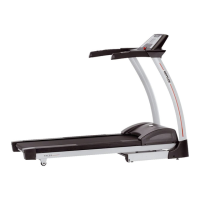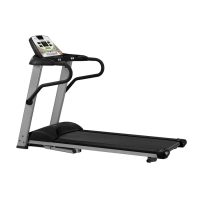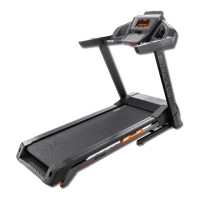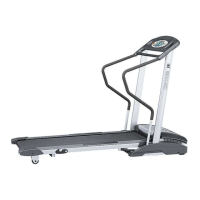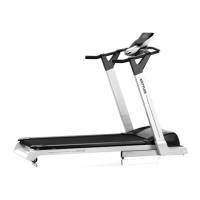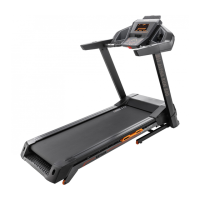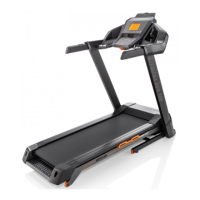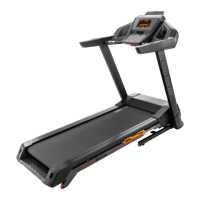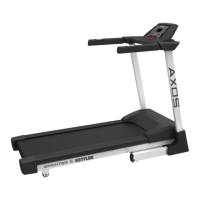Do you have a question about the Kettler Berlin S2 and is the answer not in the manual?
General safety precautions for operating the exercise device to prevent injuries.
Instructions for using the safety key and switch to stop the treadmill during training or emergencies.
Measures to prevent unauthorized use of the treadmill by third parties.
Overview of the treadmill's computer functions, programs, and key features.
Explanation of the display windows and their readings for speed, time, distance, etc.
How to switch between metric (km) and imperial (miles) units for speed display.
Detailed explanation of each button's function on the console for program selection and control.
Operation and function of the safety key for immediate shutdown and security.
How to create and use personalized training programs (U01-U03).
General safety advice and precautions to follow during treadmill operation.
Specifics on PO, P1-P36 programs, and training modes like countdowns.
How to use the body fat analysis feature and set parameters like age, height, and weight.
Body fat analysis using imperial units and parameters.
How to use Heart Rate Control programs to automatically adjust speed based on target heart rate.
Troubleshooting common issues like treadmill not working or belt slipping.
Explanations and solutions for various error codes (E1, E2, E3, E5, E7) displayed on the console.
General advice on running exercise with the treadmill for fitness.
How to plan training based on fitness level, physician diagnosis, and training principles.
Load intensity, maximum pulse, and load pulse for effective endurance training.
Recommendations for training duration, frequency, and beginner intervals.
Importance and methods for warming up before and cooling down after training.
How to correctly use hand pulse sensors for heart rate monitoring during workouts.
Specific points to observe during running, safety, and computer operation.
Description of the four phases of movement (swing, support) on a treadmill.
Different foot touchdown styles and factors affecting running technique and efficiency.
Explanation of foot pronation and its impact on running and shoe selection.
General safety precautions for operating the exercise device to prevent injuries.
Instructions for using the safety key and switch to stop the treadmill during training or emergencies.
Measures to prevent unauthorized use of the treadmill by third parties.
Overview of the treadmill's computer functions, programs, and key features.
Explanation of the display windows and their readings for speed, time, distance, etc.
How to switch between metric (km) and imperial (miles) units for speed display.
Detailed explanation of each button's function on the console for program selection and control.
Operation and function of the safety key for immediate shutdown and security.
How to create and use personalized training programs (U01-U03).
General safety advice and precautions to follow during treadmill operation.
Specifics on PO, P1-P36 programs, and training modes like countdowns.
How to use the body fat analysis feature and set parameters like age, height, and weight.
Body fat analysis using imperial units and parameters.
How to use Heart Rate Control programs to automatically adjust speed based on target heart rate.
Troubleshooting common issues like treadmill not working or belt slipping.
Explanations and solutions for various error codes (E1, E2, E3, E5, E7) displayed on the console.
General advice on running exercise with the treadmill for fitness.
How to plan training based on fitness level, physician diagnosis, and training principles.
Load intensity, maximum pulse, and load pulse for effective endurance training.
Recommendations for training duration, frequency, and beginner intervals.
Importance and methods for warming up before and cooling down after training.
How to correctly use hand pulse sensors for heart rate monitoring during workouts.
Specific points to observe during running, safety, and computer operation.
Description of the four phases of movement (swing, support) on a treadmill.
Different foot touchdown styles and factors affecting running technique and efficiency.
Explanation of foot pronation and its impact on running and shoe selection.
| Motor Power (Peak) | 2.5 HP |
|---|---|
| Running Surface | 120 x 40 cm |
| Speed | 1-16 km/h |
| Speed Range | 1-16 km/h |
| Incline | 0-12% |
| Maximum User Weight | 120 kg |
| Max User Weight | 120 kg |
| Display | LCD |
| Foldable | Yes |
| Motor Power | 1.5 HP |
| Heart Rate Monitoring | Hand pulse sensors |
| Programs | 12 |
